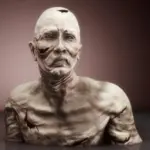
Schizophrenia spectrum disorders, abrupt cessation of alcohol consumption in addicted people, or head trauma, among other disorders, can cause the appearance of a very peculiar type of delirium: Ekbom syndrome or delusion of parasitosis.
People with this disorder believe that they have insects or other parasites on their skin, and they often continue to maintain this idea even when medical tests disprove it. Let’s see what causes this delirium and what exactly it consists of.
What is Ekbom syndrome?
Ekbom syndrome is a psychological disorder characterized by delusional belief that the person has insects under the skin, or other small parasites. This alteration is associated with the presence of tactile hallucinations and itching (constant itching in a part of the body that causes an intense urge to scratch).
Those with Ekbom syndrome may hold with great conviction the idea that they have parasites in their skin for a long time and despite evidence to the contrary obtained through medical examinations or other means. If these conditions occur, the alteration would be classified as a delusional disorder itself.
From other perspectives, Ekbom syndrome is conceived as a psychosis with delusional belief as the only symptom. This is why antipsychotic drugs such as pimozide and olanzapine are sometimes used to treat this disorder, although there are also psychological procedures to manage delusions and hallucinations.
Other names used to refer to Ekbom syndrome are “delusion of parasitosis”, “delusional parasitosis”, “dermatozoic delirium”, “parasitic delirium”, “delusion of infestation” and “imaginary parasitosis”. The ICD-10 diagnostic manual, which specifically includes this disorder, calls it “delirium of parasitosis.”
This alteration is more common in women, especially after the fifth decade of life. Some experts partially attribute this fact to the arrival of menopause, which is associated with the appearance of abnormal sensory phenomena to which the person could give a delusional interpretation, thus arising Ekbom syndrome.
Symptoms and clinical picture
Most people who have Ekbom syndrome report sensations that they attribute to the movements of insects that cross the skin or that move along the inside of it. This abnormal perception is called “formication.” and is part of the phenomena known as paresthesias, which also include pricks or numbness.
Although ants are one of the most frequently referred to “parasites” and give name to different terms used to refer to Ekbom syndrome, it is also common for people with this disorder to say that they have worms, spiders, lizards and other small animals. Sometimes they claim that these are invisible.
Under certain conditions, anyone can perceive sensations of formication, especially if there are circumstances that encourage them, such as menopause or medical disorders that affect the sensory nerves. However, the generation of delusional belief is much less common and requires some type of trigger.
There are two large categories of delusions of parasitosis depending on the nature of the alterations. We speak of primary Ekbom syndrome when the symptoms arise in the absence of identifiable problems, and therefore can be attributed to errors in the patient’s reasoning. This subtype is similar in nature to acute psychosis.
On the other hand, when an underlying alteration that triggers the delusional belief is detected, the disorder is classified as secondary. In turn, this type is divided into two: functional, which is diagnosed in cases where the syndrome is due to a psychiatric disorder such as schizophrenia, and organic, when the cause is a disease or a drug.
Related disorders and alterations
Frequently, the appearance of Ekbom syndrome is associated with a hyperactivation of the body due to the consumption of certain substances. In particular, delusional parasitosis in many cases is due to withdrawal syndrome in people with alcohol dependence or excessive consumption of cocaine or other stimulants.
In addition to psychotic disorders, other alterations in the structure and functioning of the brain can explain the emergence of this disorder. Neurodegenerative diseases (including alcoholic dementia) and head trauma, for example, are two common causes of Ekbom syndrome.
It is also interesting to mention delusional kleptoparasitosis, which is considered a subtype of Ekbom syndrome. In this variant, the person does not maintain the belief that there are bugs on her skin, but rather that they infest her residence and therefore runs the risk of being parasitized. However, it is possible and common for both disorders to occur at the same time.
Morgellons syndrome is another variant of the delusion of parasitosis in which the parasites are replaced by fibers of different types that have had contact with the skin, such as fabric or remains of bandages, or are not identified by the patient. It is a rare disorder that began to be studied a little over ten years ago.








